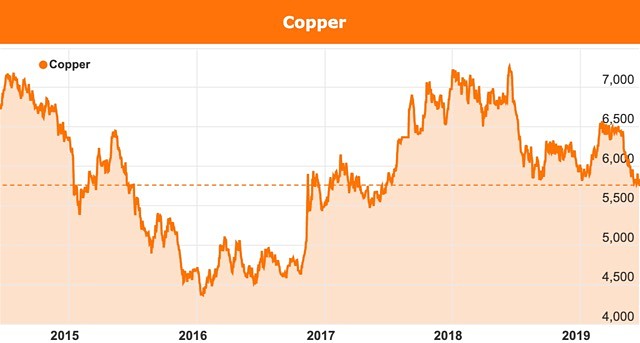Copper demand set to double in 20 years forcing miners to get more from less

Industry experts warn miners will need to rethink ways to extract copper as growth in global copper demand exceeds supply.
Copper demand is set to double within the next two decades, but miners will need to re-evaluate ways of commercialising the resource as ore levels continue to fall.
This is the warning conveyed by the International Copper Association Australia (ICAA), which correlates to data from Australia’s Office of the Chief Economist (OCE) showing growth in global copper demand is currently exceeding growth in supply.
Speaking at the Copper to the World conference in Adelaide on Tuesday, ICAA chief executive officer John Fennell said most of the world’s largest operating copper mines are more than 75 years old and while ore levels keep dropping, demand keeps rising.
“Copper use will be 26 million tonnes a year by 2040, double what it is today,” Mr Fennell said.
He said miners will be forced to “get more from less”, or search “much deeper than they have every gone before and in riskier, hard to access areas”.
Mr Fennell said this was possible with modern technologies such as artificial intelligence, robotic machinery and armies of advanced sensors, which would also produce safer, greener copper with minimal impact on people and the environment.
“Getting copper out and up from 1-2km underground would have been science fiction once but running a completely automated mine with intelligent machines and haulage from an urban centre is now possible,” he said.
However, Mr Fennell said the roll-out of copper mining technology has not been as rapid or widespread as first predicted, with adoption mainly undertaken by “big miners with deep pockets”.
“We need to ensure sure technology is identified, tested and implemented as widely as possible,” he added.
Ore decline inhibits productivity in Chile
Declining ore levels are a hurdle faced by one of the world’s copper powerhouse nations, Chile, where copper mining currently makes up 13% of the country’s gross domestic product.
Copper also accounts for 60% of its annual exports, mainly to Asian countries including the metal’s top consumer, China.
Also speaking at the copper conference, Minnovex AG vice president Juan Rayo Calderon said Chile’s biggest challenge was that its mining productivity has fallen well below that of its overseas competitors.
“Copper mining in Chile has become more and more difficult as ore bodies decline, the target rocks are increasingly harder, and water is getting far more expensive,” Mr Calderon said.
He said another issue was “human productivity, which faces rising demands of higher salaries, and increased community expectations around more environmentally sympathetic mining”.
These demands have affected not only Chile but the global copper market recently, with a strike at one of the country’s top producing copper mines being attributed to a sudden rise in copper prices.
However, Mr Calderon said a “road map” backed by Chilean government and private sector research and development initiatives to improve productivity is expected to be updated this year.
“That will assist our current gains in seeking to lift productivity while meeting higher public expectations about the way we mine,” he said.
Copper prices and outlook
Copper prices hit a five-month low of US$5,740 per tonne earlier this month but recovered overnight, boosted by a strike that slashed output in half at the Chuquicamata mine in Chile, operated by the world’s top copper producer Codelco.
According to Reuters, benchmark copper on the London Metal Exchange gained 0.5% to US$5,848/t in closing open-outcry trading after an earlier intraday low of US$5,776/t.
This price recovery was also attributed to continued declining output from China, which last month fell 5.2% year-on-year and 3.9% month-to-month to 711,000t, the news wire reported.

Historical copper prices.
Meanwhile, some analysts have warned copper and other industrial metals could be pressured by market expectations of damage to growth and demand prospects from the US-China trade dispute.
The OCE also warned in its Resources and Energy Quarterly report for March 2019 that trade tensions could counterbalance some price gains.
“However, it is also possible that investors will pay less heed to trade tensions and associated risks over time as markets adapt to the situation,” the report stated.
Another speaker at the Adelaide conference, CRU Consulting principal analyst Erik Heimlich, said the trade tensions were creating some misconceptions on pricing and impacts but the longer-term copper outlook was “robust”.
“This will see output coming through from the mines approved for development in the past 12 months – where not much additional capacity was coming to actual market – and the spate of copper mergers and acquisitions will add price improvement as worthwhile assets get better attention and investment,” Mr Heimlich said.
He added that China, which currently accounts for almost half of global copper demand, would still be a top consumer in the next five years. However, India and Asia are expected to drive global copper growth beyond 2025.
“I expect 12% of new demand in this period to come from India and around 10% from ASEAN countries – stabilising copper growth globally at around 2% a year over the next four years,” Mr Heimlich said.
With inventories near record lows, the OCE has forecast copper prices to rise significantly to US$6,978/t in 2019 before peaking at around US$8,500/t in 2021, then easing back to US$7,342/t by 2024.
